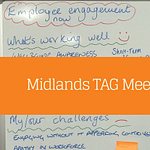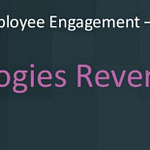Hybrid working is still very much part of the working landscapes for many organisations with over 84% of managers saying their firms were adopting it (Charter Institute of Management survey). In our recent Greater Birmingham Engage for Success meet up, we had rich sharing of what have been the lessons to date on how to make hybrid working effective across a range of sectors.
What do we mean by hybrid working?
What became clear was the diversity of perspectives on what is meant by hybrid working. For some hybrid working has been an extension of flexible working, for others it has changed how they think about work and the work environment. There is an increased move away from the standard 9-5 working to a focus on getting the job done with freedom given to employees to do work when and where they like to achieve the required outcomes. Hybrid working in other organisations is defined as a combination of virtual and workplace real time conversations and joint working.
Some organisations are moving away from the concept of a fixed office space to a more flexible approach. There is increased emphasis on consciously designing the workspace to better match to the task or any collaboration required. The aim being to align with the vision of delivering smarter and more mature ways of working. Some organisations no longer use office space, instead shifting to home working. When collaborative working is required spaces in the local community are being used.
What helps it work well
There are clearly some challenges that different organisations are experiencing by introducing hybrid working. These are often thought to be triggered by differing expectations and perspectives on what was experienced as fair. As human beings we often become emotionally triggered by practices and behaviours that we perceive as unfair. This can rapidly snowball into conflict and reduced engagement at work.
Below are some of the strategies and approaches that are being adopted by different organisations as they continue to learn how to make hybrid working effective:
- Recognising that of hybrid working is increasingly being sought after when applying for a jobs
- Being clear about the purpose and what you are trying to achieve with hybrid working and ensure this is communicated
- Acknowledging that for some employees it is a big mindset and cultural shift to be given choice over when and where to work to deliver the required output
- Structuring time to develop increased understanding between those who must be in the workplace due to their role and those who have the option to work from home.
- When there is limited time for connection between colleagues, plan them to be moments that matter to them
- Be explicit about expectations, for example if there are requirements on having specific days in the office. Manage those expectations with both with staff and senior managers e.g. if the focus of the day in the office is on connecting and collaborating: let managers know that on those days output maybe lower and staff know which activities are required from attendance
- Some organisations are developing overarching principles for hybrid working that could be adapted by local teams. Some had taken this one step further, encouraging teams to develop their own charters for hybrid working.
- Taking time to connect, listen and understand each other when conflict over fairness arose. The team charters were found to be useful to support dialogue in these situations.
- Consciously attending to staff wellbeing through regular conversations with managers
- Be clear about whether your focus is on creating equality of working arrangements or focusing on what the employee needs to be most productive.
- Rethinking onboarding. For new staff, particularly those at an early stage in their career, picking up skills and practices through observation and informal conversations at work was seen as important to preserve in hybrid working.
Based on the practice shared by different organisations, Hybrid working is increasingly being seen as mindset rather than a hard and fast policy. It requires a flexible framework that encouraged individuals and teams to agree the best hybrid mix of remote and face-to-face working around four factors:
- Business needs
- Individual job requirements
- Individual needs and preferences
- Team effectiveness
Whatever the approach to hybrid working going forward, it clearly has many supporters. To be able to continue to deliver business benefits these need to be navigated in a way that has a clear strategic narrative and includes employee engagement front of mind.
Ann Terry – Engaging Solutions and Volunteer Greater Birmingham EfS Network




